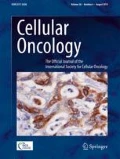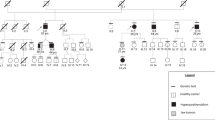Abstract
Purpose
The CDC73 gene, encoding parafibromin, has been identified as a tumour suppressor gene both in hyperparathyroidism-jaw tumour (HPT-JT) syndrome and in sporadic parathyroid carcinoma. While the vast majority of CDC73 mutations affect the N-terminus or the central core of the encoded protein, as yet few mutations have been reported affecting the C-terminus. Here, we report a case (Caucasian female, 28 years) with an invasive ossifying fibroma of the left mandible and hyperparathyroidism (sCa = 16 mg/dl, PTH = 660 pg/mL) due to a parathyroid lesion of 20 mm, hystologically diagnosed as carcinoma.
Methods
The whole CDC73 gene was screened for the presence of mutations by Sanger sequencing. Immunohistochemistry, in vitro functional assays, Western blotting, MTT assays and in-silico modelling were performed to assess the effect of the detected mutation.
Results
Sequence analysis of the CDC73 gene in the proband revealed the presence of a novel deletion affecting the C-terminus of the encoded protein (c.1379delT/p.L460Lfs*18). Clinical and genetic analyses of the available relatives led to the identification of three additional carriers, one of whom was also affected by a parathyroid lesion. Immunohistochemistry, Western blotting, MTT and in-silico modelling assays revealed that the deletion leads to down-regulation of the mutated protein, most likely through a proteasome-mediated pathway. We also found that the deletion may cause a conformational change in the C-terminus of the protein, possibly affecting its interaction with partner proteins. Finally, we found that the mutant protein enhances cellular growth.
Conclusions
We report a novel mutation in the CDC73 gene that may underlie HPT-JT syndrome. This mutation appears to affect the C-terminal moiety of the encoded protein, which is thought to interact with other protein partners. The identification of these partners may be instrumental for our understanding of the CDC73-associated phenotype.





Similar content being viewed by others
References
C.E. Jackson, R.A. Norum, S.B. Boyd, G.B. Talpos, S.D. Wilson, R.T. Taggart, L.E. Mallette, Hereditary hyperparathyroidism and multiple ossifying jaw fibromas: a clinically and genetically distinct syndrome. Surgery 108, 1006–12 (1990)
K.J. Bradley, M.R. Hobbs, I.D. Buley, J.D. Carpten, B.M. Cavaco, J.E. Fares, P. Laidler, S. Manek, C.M. Robbins, I.S. Salti, N.W. Thompson, C.E. Jackson, R.V. Thakker, Uterine tumours are a phenotypic manifestation of the hyperparathyroidism-jaw tumour syndrome. J Int Med. 257, 18–26 (2005)
J.D. Carpten, C.M. Robbins, A. Villablanca, L. Forsberg, S. Presciuttini, J. Bailey-Wilson, W.F. Simonds, E.M. Gillanders, A.M. Kennedy, J.D. Chen, S.K. Agarwal, R. Sood, M.P. Jones, T.Y. Moses, C. Haven, D. Petillo, P.D. Leotlela, B. Harding, D. Cameron, A.A. Pannett, A. Höög, L.A. James-Newton, B. Robinson, R.J. Zarbo, B.M. Cavaco, W. Wassif, N.D. Perrier, I.B. Rosen, U. Kristoffersson, P.D. Turnpenny, L.O. Farnebo, G.M. Besser, C.E. Jackson, H. Morreau, J.M. Trent, R.V. Thakker, S.J. Marx, B.T. Teh, C. Larsson, M.R. Hobbs, HRPT2, encoding parafibromin, is mutated in hyperparathyroidism-jaw tumor syndrome. Nat Gen. 32, 676–80 (2002)
T.M. Shattuck, S. Välimäki, T. Obara, R.D. Gaz, O.H. Clark, D. Shoback, M.E. Wierman, K. Tojo, C.M. Robbins, J.D. Carpten, L.O. Farnebo, C. Larsson, A. Arnold, Somatic and germ-line mutations of the HRPT2 gene in sporadic parathyroid carcinoma. N. Engl. J. Med. 349, 1722–29 (2003)
A. Yart, M. Gstaiger, C. Wirbelauer, M. Pecnik, D. Anastasiou, D. Hess, W. Krek, The HRPT2 tumor suppressor gene product parafibromin associates with human PAF1 and RNA polymerase II. Mol. Cell. Biol. 25, 5052–60 (2005)
O. Rozenblatt-Rosen, T. Nagaike, J.M. Francis, S. Kaneko, K.A. Glatt, C.M. Hughes, T. LaFramboise, J.L. Manley, M. Meyerson, The tumor suppressor CDC73 functionally associates with CPSF and CstF 3’ mRNA processing factors. Proc. Natl. Acad. Sci. U. S. A. 106, 755–6 (2009)
C. Mosimann, G. Hausmann, K. Basler, Parafibromin/Hyrax activates WNT/Wg target gene transcription by direct association with b-catenin/Armadillo. Cell 125, 327–341 (2006)
P.J. Newey, M.R. Bowl, T. Cranston, R.V. Thakker, Cell division cycle protein 73 homolog (CDC73) mutations in the hyperparathyroidism-jaw tumor syndrome (HPT-JT) and parathyroid tumors. Hum Mut. 31, 295–307 (2010)
V. Pazienza, A. la Torre, F. Baorda, M. Alfarano, M. Chetta, L.A. Muscarella, C. Battista, M. Copetti, D. Kotzot, K. Kapelari, D. Al-Abdulrazzaq, K. Perlman, E. Sochett, D.E. Cole, F. Pellegrini, L. Canaff, G.N. Hendy, L. D’Agruma, L. Zelante, M. Carella, A. Scillitani, V. Guarnieri, Identification and functional characterization of three NoLS (Nucleolar Localisation Signals) mutations of the CDC73 gene. PLoS One 8, e82292 (2013)
V. Guarnieri, C. Battista, L.A. Muscarella, M. Bisceglia, D. de Martino, F. Baorda, E. Maiello, L. D’Agruma, I. Chiodini, C. Clemente, S. Minisola, E. Romagnoli, S. Corbetta, R. Viti, C. Eller-Vainicher, A. Spada, M. Iacobellis, N. Malavolta, M. Carella, L. Canaff, G.N. Hendy, D.E. Cole, A. Scillitani, CDC73 mutations and parafibromin immunohistochemistry in parathyroid tumors: clinical correlations in a single-centre patient cohort. Cell. Oncol. 35, 411–22 (2010)
M. Cantile, G. Scognamiglio, L. La Sala, E. La Mantia, V. Scaramuzza, E. Valentino, F. Tatangelo, S. Losito, L. Pezzullo, M.G. Chiofalo, F. Fulciniti, R. Franco, G. Botti, Aberrant expression of posterior HOX genes in well differentiated histotypes of thyroid cancers. Int. J. Mol. Sci. 14, 21727–40 (2013)
http://www.mutationdiscovery.com/md/MD.com/home_page.jsp, last access: June 2014
http://www.ncbi.nlm.nih.gov/variation/tools/1000genomes, last access: June 2014
H. Chen, N. Shi, Y. Gao, X. Li, M. Teng, L. Niu, Crystallographic analysis of the conserved C-terminal domain of transcription factor Cdc73 from Saccharomyces cerevisiae reveals a GTPase-like fold. Acta Crystallogr. D Biol. Crystallogr. 68, 953–9 (2012)
F.J. Pimenta, L.F. Gontijo Silveira, G.C. Tavares, A.C. Silva, P.F. Perdigão, W.H. Castro, M.V. Gomez, B.T. Teh, L. De Marco, R.S. Gomez, HRPT2 gene alterations in ossifying fibroma of the jaws. Oral Oncol. 42, 735–9 (2006)
C. Haag, S. Pauli, E. Schulze, K. Frank-Raue, F. Raue, Hyperparathyroidism-jaw tumor syndrome (HPT-JT): a new mutation in the HRPT2-gene. Endocr. Abstr. 16, 73 (2008)
K.J. Bradley, M.R. Bowl, S.E. Williams, B.N. Ahmad, C.J. Partridge, A.L. Patmanidi, A.M. Kennedy, N.Y. Loh, R.V. Thakker, Parafibromin is a nuclear protein with a functional monopartite nuclear localization signal. Oncogene 26, 1213–21 (2007)
M.A. Hahn, D.J. Marsh, Nucleolar localization of parafibromin is mediated by three nucleolar localization signals. FEBS Lett. 581, 5070–4 (2007)
O. Rozenblatt-Rosen, C.M. Hughes, S.J. Nannepaga, K.S. Shanmugam, T.D. Copeland, T. Guszczynski, J.H. Resau, M. Meyerson, The parafibromin tumor suppressor protein is part of a human Paf1 complex. Mol. Cell. Biol. 25, 612–62 (2005)
T. Iwata, N. Mizusawa, Y. Taketani, M. Itakura, K. Yoshimoto, Parafibromin tumor suppressor enhances cell growth in the cells expressing SV40 large T antigen. Oncogene 26, 6176–83 (2007)
C.G. Amrich, C.P. Davis, W.P. Rogal, M.K. Shirra, A. Heroux, R.G. Gardner, K.M. Arndt, A.P. VanDemark, Cdc73 subunit of Paf1 complex contains C-terminal Ras-like domain that promotes association of Paf1 complex with chromatin. J. Biol. Chem. 287, 10863–75 (2012)
Acknowledgements
The Authors gratefully acknowledge the patients and the family participating in this study, and Andreina Guarnieri for the helpful English language revision of the manuscript. This work was supported by the Ricerca Corrente 2012 funding (to VG), granted by the Italian Ministry of Health and by the “5x1000” voluntary contributions.
Conflict of interest
The author (s) declare that they have no conflict of interest.
Ethical standards
The Authors declare that the experiments comply with the current laws of the country in which they were performed.
Author information
Authors and Affiliations
Corresponding author
Rights and permissions
About this article
Cite this article
Chiofalo, M.G., Sparaneo, A., Chetta, M. et al. A novel CDC73 gene mutation in an Italian family with hyperparathyroidism-jaw tumour (HPT-JT) syndrome. Cell Oncol. 37, 281–288 (2014). https://doi.org/10.1007/s13402-014-0187-3
Accepted:
Published:
Issue Date:
DOI: https://doi.org/10.1007/s13402-014-0187-3




